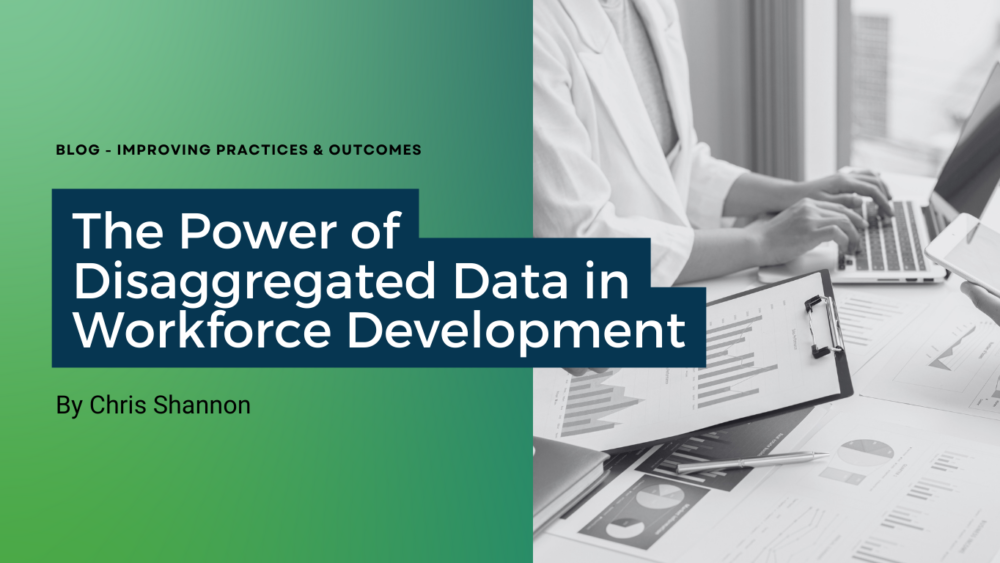A November 2023 report developed by the American Institutes for Research (AIR) for the U.S. Department of Labor (DOL) explores promising practices that can be scaled to strengthen the workforce development system. This report builds on recently released DOL guidance highlighting strategies improving equity in training outcomes for underserved communities. DOL’s guidance states that their analysis of WIOA program data, in addition to a portfolio of evidence from evaluations of training programs, suggests that completing a training program aligned with strategies and approaches with an empirical basis may increase wage and employment outcomes for individuals.
The AIR report promotes three evidence-based workforce training recommendations that support positive and more equitable outcomes across populations served:
- Strengthen investments in evidence-informed services and provide individualized services and supports.
- Use data to identify disparities, and partner with service institutions and employers on program referrals, job development, and supports.
- Expand recruitment approaches, provide key program information, and streamline program requirements.
The second of these recommendations urges workforce agencies to “use data to identify disparities.” This includes investing in data and analysis to examine differences in service provision, engagement, completion, and other outcomes across different socio-economic groups. Here at CSW, we argue that workforce practitioners take this a step further by disaggregating the data by barriers, outcomes, gender, and race.
Data disaggregation means breaking down information into smaller sub-populations, for example by gender or age. This process helps to see beyond the number of people reached through your services and programs. Disaggregated data is key to spotlighting where racial and gender equity gaps exist and provides a baseline from which progress can be measured. By examining more nuanced data, you will have a stronger sense of who is being served well by your programming and where your programming can be strengthened to ensure positive outcomes across all subgroups.
One resource workforce service providers can use to disaggregate data is through the Workforce Benchmarking Network (WBN). The WBN is a collective of workforce organizations—along with public and private funders and other intermediaries—who are committed to improving their programming and outcomes through optimizing data collection and data benchmarking. The goal of the WBN is to improve outcomes for job seekers, employers, and communities–particularly individuals living in poverty and those affected by systemic racism and gender disparities–by ensuring that more quality data about services and outcomes are available across the field.
However, sometimes workforce reporting tools do not provide the ability to disaggregate data, or the data is reported to regional or state workforce agencies that may lack feedback loops, hindering the ability of frontline staff to create targeted interventions to address leaks in the participant pipeline. The WBN National Survey is a simple, accessible, and free resource that allows workforce organizations to craft custom reports that can identify gaps in participant recruitment, enrollment, retention, placement, and wages.
The WBN National Survey also allows workforce organizations to compare their program outcomes to other organizations of a similar size and focus, allowing them to benchmark their services and outcomes in an apples-to-apples comparison in a way they can’t do through their regional or state workforce agencies. Since 2008, over 500 organizations from across 26 states have input data into the National Survey, making direct comparisons between your organization and similar workforce organizations that much more powerful.
The Survey tool includes 10 reports that answer the following questions for organization that submit data:
- How are answers to specific survey questions spread across programs in the dataset?
- How do my results compare to mid-point and high-performance levels for an outcome?
- What types of participants and services are represented by programs that submitted surveys?
- How does wage information submitted vary by gender and how do we compare?
- How does wage information submitted vary by race and ethnicity and how do we compare?
- How do non-wage outcomes submitted vary by gender and how do we compare?
- How do non-wage outcomes submitted vary by race and ethnicity and how do we compare?
By disaggregating data to answer these questions, you can assess if your outcomes reflect your organizational priorities. For example, one of our WBN National Survey cohort participants disaggregated their outcome data to find that outcomes for women throughout the entire program lifecycle were significantly lower than those of their male participants. Disaggregating data may reveal disparities in participant engagement and retention through the program pipeline, enabling staff to dig deeper into potential root causes and potential shifts in practices, processes, or supports. It can also help identify potential gaps in data collection; often participating organizations come across data requested for Survey completion and realize how they might benefit from adding that data point to their intake or case management processes. The National Survey is a great resource for organizations that want to up their data game to address program inequities and improve program outcomes.
Although access to free quality tools and resources is always welcomed, some workforce entities recognize that creating an internal culture of using data for learning could be even more impactful. Others see value in bringing in an external partner to lead staff development and capacity-building to challenge any internal operating assumptions and deepen data capabilities across roles and functions.
If strengthening your organization’s data capacity is a goal for 2024, contact our team at CSW. We can provide direct technical assistance to help improve your organization’s data culture. If you have funding partners who care about equity in program outcomes, we can work with you to build a cohort of regional providers to build individual and collective data cultures, making it easier to benchmark progress, create regional goals, and collaborate to move regional systems change.

Meet the Author
Chris Shannon
Chris is a Senior Policy Associate with CSW’s Improving Practices and Outcomes Team. Chris supports systems change and transformation by developing organizational capacity through learning conversations, data analysis, and promoting shared insights to benefit systems. Continue Reading >>



Comments are closed.